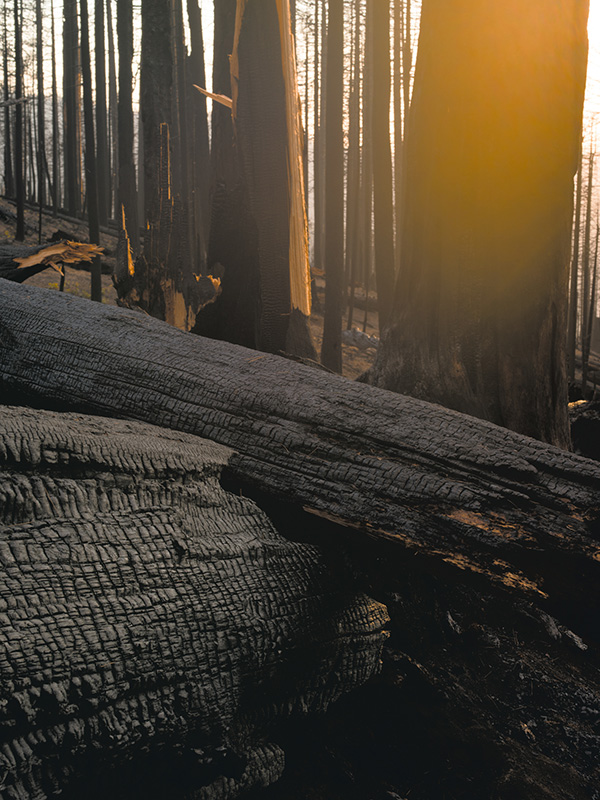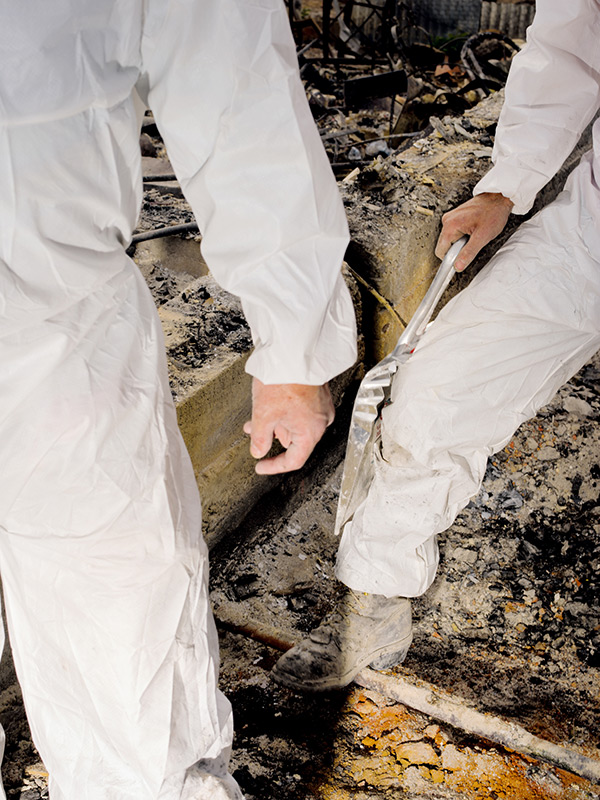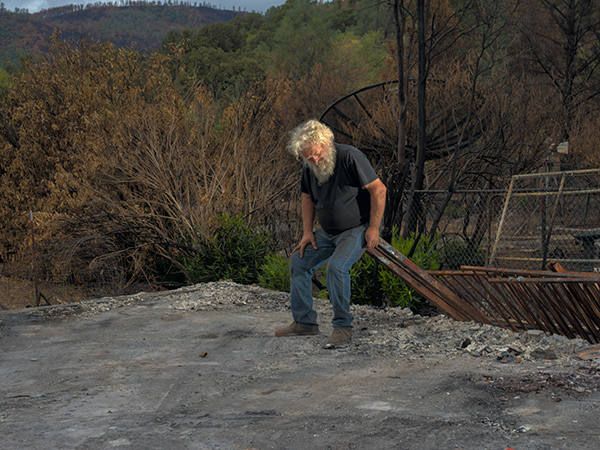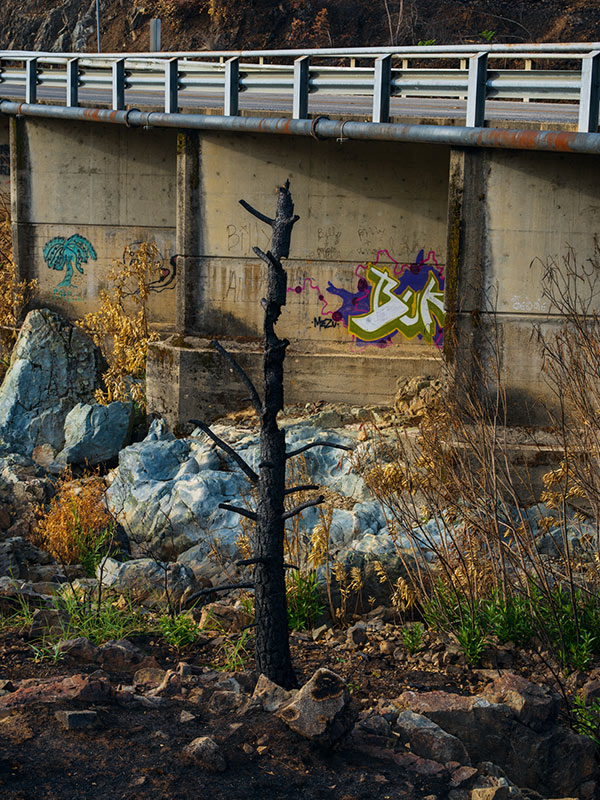California on Fire

Carolyn Drake, Forest view at sunset, two months after the Ferguson Fire, Yosemite West, California, for Aperture, 2018
© the artist/Magnum Photos
Every fire has a narrative. For major wildfires, there are numbers to help frame the narrative, and usually a name. But all fires start long before they start, in the sense that the ground must be prepared, literally, for the conflagration to come. Fuel, weather (and behind weather, climate), the natural landscape, the built landscape, suppression efforts past and present, prevention schemes, politics—these factors and many others, interacting and colliding, create a context and prehistory for each major fire. The fire itself burns and then takes its place both in recorded history and in the natural history of its epoch. That epoch, now, is the Anthropocene—the epoch of a world made by humans.

Carolyn Drake, Wawona campground in Yosemite National Park, two months after the Ferguson fire, Yosemite West, California, for Aperture, 2018
© the artist/Magnum Photos
To make these images in California’s disaster-struck areas, Carolyn Drake chose the long moments after a series of major wildfires. The flames and smoke, the panic and news crews, are gone. The land is charred, ashes are sifted, burned-out residents return, campgrounds reopen. The fury and violence of the vast event recede, and the world that’s left behind becomes specific again, inviting contemplation. Three big wildfires broke out in Northern and central California in July 2018 and burned through the following weeks. Drake tracked and photographed the aftermaths of all three.

Carolyn Drake, Archaeologists search for a jar containing the ashes of a widow’s husband after her house burned down, Redding, California, for Aperture, 2018
© the artist/Magnum Photos
The Ferguson Fire was started by a vehicle’s overheated catalytic converter in dry vegetation beside a highway in Mariposa County. This was in the Sierra foothills southwest of Yosemite National Park. The fire burned into the park, and its smoke filled Yosemite Valley, the most popular (and most photographed) destination in the Sierra Nevada mountains. The valley was closed and evacuated. It became a staging area for firefighting operations. Roughly three thousand firefighters were thrown at the fire. Two died. One was a bulldozer operator, killed when his vehicle rolled down a mountainside. The other, a captain of an elite crew whose members work in the most dangerous areas of wildfires, was killed by a falling tree. Nineteen other firefighters were injured. The Ferguson Fire took more than a month to contain. It burned almost ninety-seven thousand acres.

Carolyn Drake, Fire roads cross privately owned mountains, three weeks after the Mendocino Complex Fire finished burning, Spring Valley, California, for Aperture, 2018
© the artist/Magnum Photos
The Carr Fire was started by a flat tire, which sent a wheel rim onto asphalt, where it generated sparks, igniting dry vegetation. This occurred in the mountains west of the city of Redding. Three days later, the fire jumped the Sacramento River and entered Redding, forcing the evacuation of thirty-eight thousand people. That same evening, a fire whirl developed—a tornado-like column of superheated air that can be generated by intense wildfires. The Redding fire whirl contained winds exceeding 143 miles per hour. The wind tore roofs from houses, bark from trees, and toppled high-tension power-line towers. The fire whirl was reported to be forty thousand feet tall. The Carr Fire killed eight people, including three firefighters. It burned more than a thousand homes. Insured losses were estimated at $1.5 billion. The cost of fire insurance is said to be soaring in California, moving beyond the reach, effectively, of many residents in fire-prone areas.

Carolyn Drake, Lounge in the Usona Forest Fire Station, Mariposa County, California, for Aperture, 2018
© the artist/Magnum Photos
Finally, the Mendocino Complex Fire started as two vegetation fires in the chaparral-covered mountains near Clear Lake, about one hundred miles north of San Francisco and fifty miles from the coast. The ignition point is still under investigation. In hot, dry, windy conditions, the fire burned for nearly two months, ultimately consuming more than 450,000 acres, which makes it the largest wildfire in California history. It destroyed 280 structures, most of them rural residences, many in unincorporated communities like Spring Valley. One firefighter died. He was a battalion chief from Utah, killed by a falling tree. The firefighters struggling to contain the Mendocino Complex Fire were hampered by a manpower shortage—many of their brethren were off working other fires. Nevada state prison inmates, among others, were deployed to fight the enormous blaze, and suppression costs ran to more than $200 million.

Carolyn Drake, Rod on the foundation of his burned home after the Mendocino Complex Fire, Spring Valley, California, for Aperture, 2018
© the artist/Magnum Photos
Wildfires are getting bigger, hotter, more frequent, more destructive. Of the ten most destructive fires (measured by destroyed structures) in the history of California, six have occurred in 2017 or 2018. The single deadliest and most destructive, the Camp Fire, in Butte County, is still smoldering as I write, in November 2018. This fire, which essentially destroyed the small city of Paradise, California, on November 8, killed eighty-eight people, with 249 more still listed as missing. It burned more than thirteen thousand homes, and archaeologists are working among the ruins now to find any traces, such as teeth, of the perished. The second most destructive California wildfire, the Tubbs Fire, in Napa and Sonoma Counties, did its gruesome thing in October 2017. It killed twenty-two people and burned more than five thousand structures, including some 2,900 homes in the city of Santa Rosa.

Carolyn Drake, A creek overpass, one month after the Carr Fire, Redding, California, for Aperture, 2018
© the artist/Magnum Photos
Why this biblical plague of fire? It is the Anthropocene, and we must look to our own agency. The climate is hotter and, in California, much drier than in the recent past because of the greenhouse effect, which is caused, primarily, by the burning of fossil fuels. In the American West, as in other places, logging practices have produced vast amounts of slash—woody debris that burns more readily than the mature forests it replaced. Overzealous fire suppression policies have contributed, paradoxically, to the proliferation of bad fires. They have left a tree-choked landscape, where natural fires caused by lightning have been unable to do their ecological job of thinning.
Then there is the mass migration of people into what land-use jargon calls the wildland-urban interface (WUI)—the zone where residences abut forests or other combustible vegetation. This is by far the fastest-growing land-use type in the United States. More than one hundred million souls now live in the American WUI. These people accidentally start a great many fires, and their presence makes firefighting harder and more dangerous. Natural fires cannot be allowed to burn themselves out anywhere in or near the WUI.

Carolyn Drake, Charred landscape, one month after the Carr Fire, Redding, California, for Aperture, 2018
© the artist/Magnum Photos
These calamitous trends and policies form some of the context, the prehistory, of the wildfires that rage in our day. These problems are national, if not international; climate change is, of course, global. But here is Stephen Pyne, the preeminent American scholar of fire, on California, its particular problems, and the larger picture:
California is a special case. It’s a place that nature built to burn, often explosively. If people vanished, fires would still thrive. … But people have worsened the scene. They have introduced flammable grasses, overgrazed in the mountains and felled forests in ways that overturned the prior system of ecological checks and balances. … And then Earth’s keystone species for fire decided to burn fossil biomass, which has cascaded effects throughout the planet and unhinged the climate. We used to think fire history was a subset of climate history; now climate history is becoming a subset of fire history.
I see this dilemma, this mess, in Drake’s pictures. They are not about simply the harsh aftermath of natural disasters. They are about the role of humans, and of Drake’s own observing eye, in this burning world we’ve made.
Read more from Aperture issue 234, “Earth,” or subscribe to Aperture and never miss an issue.


























